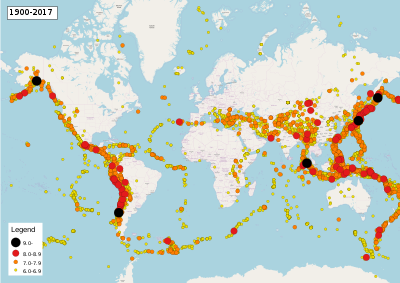
Back Ring van Vuur Afrikaans منطقة الحزام الناري Arabic صمطة لعوافي دلمحيط لمهدن ARY Cinturón de Fueu del Pacíficu AST Bungkung Api Pasifik BAN Singsing nin Kalayo BCL Ціхаакіянскае вогненнае кальцо Byelorussian Тихоокеански огнен пръстен Bulgarian আগুনের বৃত্ত Bengali/Bangla Pacifički vatreni prsten BS



The Pacific Ring of Fire is an arc around the Pacific Ocean where many volcanoes and earthquakes are formed.[1] The area is also called the Pacific Rim, a term which refers to the coastal areas of the countries round the Pacific.[2]
About three quarters of the world's dormant volcanos and active volcanos are here. The ring is 40,000km long, and there are 452 volcanoes.[3]
About 90%[4] of the world's earthquakes and 81%[5] of the world's largest earthquakes occur along the Ring of Fire. The next most seismic region (5–6% of earthquakes and 17%[5] of the world's largest earthquakes) is the Alpide belt, which extends from Java to Sumatra through the Himalayas, the Mediterranean, and out into the Atlantic. The Mid-Atlantic Ridge is the third most prominent earthquake belt.[6][7]
The Ring of Fire is a direct result of plate tectonics and the movement and collisions of crustal plates.[8]
- ↑ "The Ring of Fire: home to the majority of the world's active volcanoes". ThoughtCo. Retrieved 2018-08-22.
- ↑ Linda, Wojtan (1987). "Teaching about the Pacific Rim. ERIC Digest No. 43". ERIC DIGEST. Archived from the original on 8 March 2016. Retrieved 22 August 2018.
- ↑ "Ring of Fire - Pacific Ring of Fire". Geography.about.com. 2010-06-14. Archived from the original on 2010-12-04. Retrieved 2010-11-01.
- ↑ "Earthquake Glossary". earthquake.usgs.gov. Retrieved 2017-11-01.
- ↑ 5.0 5.1 "Earthquake Facts & Earthquake Fantasy". earthquake.usgs.gov. Archived from the original on 2017-12-13. Retrieved 2017-11-01.
- ↑ U.S. Geological Survey Earthquakes FAQ Archived 2006-01-17 at the Wayback Machine.
- ↑ U.S. Geological Survey Earthquakes Visual Glossary Archived 2005-12-10 at the Wayback Machine.
- ↑ "Moving slabs". Archived from the original on 1997-10-11.